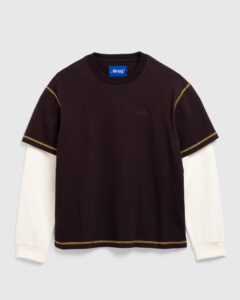When Oakley first emerged in 1975, few could have predicted that a small brand selling motocross grips out of a garage in Southern California would transform into one of the most innovative eyewear and sports performance companies on the planet. As Oakley marks its 50th anniversary in 2025, it is not merely celebrating a milestone in years but rather half a century of pushing boundaries, merging science with aesthetics, and rewriting the possibilities of design.
The brand’s journey is a testament to the belief that physics and art are not mutually exclusive but rather two sides of the same coin. Oakley’s evolution has been driven by a philosophy that refuses to accept convention, viewing every product not just as an item but as a canvas for experimentation and a tool for human performance enhancement.
The Origins: Beyond Grips
Oakley was founded by James Jannard with an initial investment of just $300. His first product wasn’t a pair of sunglasses but a line of motorcycle grips called “The Oakley Grip,” designed to offer superior traction through a unique, patented material called Unobtainium. This material would become a hallmark of Oakley design for decades to come, eventually finding its way into eyewear nose pads and temple sleeves to improve fit and comfort.
Jannard’s approach was simple yet revolutionary: design from the molecular level up. Instead of focusing solely on outward appearance, he prioritized function, ergonomics, and material science. This philosophy set Oakley apart and laid the foundation for its future success in eyewear and beyond.
A Vision for the Future: The Introduction of Eyewear
In the 1980s, Oakley turned its gaze to eyewear, a category dominated by traditional fashion frames and basic sun protection. The introduction of the O-Frame goggle in 1980, followed by the Eyeshade in 1984, marked the brand’s first foray into high-performance eyewear.
The Eyeshade was a radical departure from anything else on the market. With its futuristic shape and extended lens coverage, it was designed to shield athletes from wind and debris while enhancing visual clarity. Legendary cyclist Greg LeMond was one of the first athletes to adopt the Eyeshade, helping cement Oakley’s reputation as the go-to brand for elite performers.
From the beginning, Oakley understood that eyewear wasn’t merely an accessory — it was an essential piece of equipment. This athlete-centric approach would become a defining element of the brand’s identity, fusing scientific research with ergonomic artistry.
Innovation as a Constant: The 1990s Boom
The 1990s represented a golden era for Oakley. The release of the M-Frame in 1989 set a new standard for interchangeable lens technology and modular design. The Juliet and X-Metal series further pushed the envelope, introducing sculptural, aerospace-grade titanium frames that looked like wearable sculptures as much as they did sports gear.
At a time when fashion eyewear often leaned towards minimalism or retro nostalgia, Oakley was unapologetically futuristic. The aesthetic was bold, almost alien, and infused with the brand’s mantra of “disruptive by design.” The blend of industrial design, aerodynamics, and advanced materials created products that could only be described as art pieces molded by physics.
The creation of Oakley’s High Definition Optics (HDO) was another groundbreaking moment. HDO ensured that lenses met rigorous optical standards for clarity, refraction, and impact resistance — a true union of science and visual performance.
Culture, Art, and Beyond the Track
Beyond its technical prowess, Oakley’s influence seeped deeply into popular culture. The eyewear became emblematic of rebellion and forward-thinking style, worn by athletes, rock stars, and even characters in Hollywood blockbusters like “Blade II” and “X-Men.”
By the late 1990s and early 2000s, Oakley had firmly established itself as a symbol of performance lifestyle. It wasn’t just about sports anymore; it was about a mindset that championed innovation, individuality, and risk-taking.
Flow with artists and designers, such as the collaboration with Kato for a face-conforming goggle that blurred the line between performance and conceptual art, showcased Oakley’s willingness to experiment with form and identity. Each product became a statement piece, merging functional science with sculptural aesthetics.
The Intersection of Physics and Art
Oakley’s core belief lies in the seamless fusion of physics and art. Every curve, vent, and lens tint is meticulously calculated. The engineering behind a pair of Oakley sunglasses involves advanced simulations to understand airflow, weight distribution, and optical clarity. Meanwhile, the final forms are sculpted with an artist’s eye for drama and character.
This philosophy extends beyond eyewear. Oakley’s apparel, helmets, and even footwear embody the same experimental spirit. Products are designed not just to look good but to perform under the most challenging conditions, often incorporating proprietary materials and technologies.
The “Aero” series, for example, exemplifies this balance. These pieces are designed to reduce drag for cyclists and triathletes, combining sleek silhouettes with advanced moisture-wicking and breathability features. Such innovations highlight Oakley’s refusal to draw a line between art and utility.
Fifty Years Young: Looking Forward
As Oakley celebrates its 50th anniversary, it doesn’t rest on nostalgia. Instead, the brand looks forward, emphasizing sustainability, digital innovation, and broader cultural collaborations.
In recent years, Oakley has introduced new manufacturing methods focused on reducing environmental impact, such as bio-based frame materials and eco-friendly packaging. The brand’s research and development labs continue to explore adaptive lenses and smart eyewear, including augmented reality integrations for training and safety.
The push into digital realms also opens doors for artistic exploration. Conceptual artist collaborations, immersive virtual try-on experiences, and dynamic customization options are redefining how customers interact with Oakley products.
This willingness to explore and disrupt ensures that Oakley remains at the forefront of the industry — not just as a manufacturer of sports equipment, but as a culture innovator.
Celebrating with the World: The 50th Anniversary Collection
To mark this golden milestone, Oakley has launched a special 50th-anniversary collection that revisits iconic silhouettes with modern updates. Limited-edition versions of the M-Frame, Radar, and Jawbreaker feature exclusive colorways, reimagined lens tints, and commemorative engravings.
These pieces aren’t simply re-releases; they are recontextualized tributes, acknowledging the brand’s rich heritage while pushing forward with new materials and production techniques.
The collection embodies everything Oakley stands for: performance, individuality, and the continual blending of technical mastery with artistic vision. Fans and collectors are already clamoring for these models, seeing them as wearable pieces of history.
The Legacy of Disruption
Looking back over fifty years, Oakley’s journey stands as a case study in radical innovation. Where others saw limitations, Oakley saw opportunities to innovate — whether through the molecular engineering of materials or the radical rethinking of traditional shapes.
This legacy of disruption resonates beyond the products themselves. It has influenced how athletes approach performance gear, how designers conceive of form and function, and how everyday consumers perceive the potential of eyewear.
Oakley’s dedication to merging physics with art has fostered a unique community of believers: athletes who push human limits, artists who challenge norms, and wearers who embody the spirit of defiance and creativity.
Beyond 50: The Next Frontier
What lies beyond 50 years? For Oakley, the future is a canvas. As wearable technology advances and human performance continues to evolve, Oakley is poised to lead the next wave of innovations at the intersection of biology, optics, and digital experiences.
Imagine eyewear that adapts in real time to lighting changes, or frames that provide biometric feedback. Picture advanced AI-powered lenses that help athletes correct form on the fly or assist rescue workers in hazardous environments.
With an unyielding commitment to pushing past the ordinary, Oakley’s next chapters promise to be as radical and inspiring as its first fifty years.
Impression
Oakley’s 50-year anniversary is more than just a birthday celebration — it is a testament to the enduring power of imagination fueled by scientific rigor. By consistently merging physics and art, Oakley has not only redefined what performance gear can be but has also reshaped the cultural landscape.
As we look forward to the next fifty years, one thing remains certain: Oakley will continue to blur the lines between utility and beauty, creating objects that aren’t just worn but lived in. And for those who believe that science and art belong together, Oakley’s story is a shining example of what is possible when you refuse to compromise.
No comments yet.









